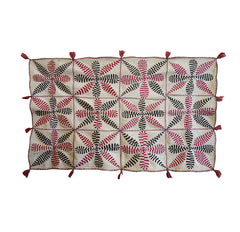A Wonderfully Good Bengali Kantha: Off-Grid
mid twentieth century
18" x 29", 45.75 cm x 73.75 cm
The kantha stitched textiles from Bangladesh and West Bengal in India are well-known folk textiles and are among India's most prized textile legacies.
Kantha stitching has its roots in ingenuity and the culture of women: used whitedhotis (men's sarongs) and women's sarees were salvaged, cut and layered: thread from the colored, embroidered borders of the used garments were pulled free from the rags and used as embroidery threads for quilted work, the border threads usually being black and red, blue and red, and sometimes yellow, orange and green. Quilts, bags and clothing were embroidered using a running, stem and satin stitch, the quilts and coverlets were constructed of many layers, the number of layers dependent of the weather of the region where a particular kantha was stitched.
Kanthas were stitched by both Hindu and Muslim women, and the variety of motives and patterns employed by these women calls up the rich cultural history of Eastern India and Bangladesh as well as the individual voices of the women who made these kanthas.

